There are no guarantees in the outcomes of clinical studies. That’s why we conduct the trials! However, on the path of any study-related project there are essential steps that can contribute to a greater potential for success. Best practice efforts to enhance effective team interactions and communications are a part of these essentials. The ‘world of work’ we live in is more often a global development effort that requires virtual team participants. Added complexities include people in different time zones and countries, speaking different languages with diverse perspectives and backgrounds. Having a shared understanding, mutual expectations, aligned commitment and trust in one another are all necessary requirements for any team success, regardless of whether it’s virtual or co-located.
When partnering with a CRO, you’re about to enter into a long lasting relationship. You and your company have invested time and money in selecting what you believe is the best outsourcing partner. One key to making this partnership work over the life of any project is effective communication.
How well do you really know your competitors?
Access the most comprehensive Company Profiles on the market, powered by GlobalData. Save hours of research. Gain competitive edge.

Thank you!
Your download email will arrive shortly
Not ready to buy yet? Download a free sample
We are confident about the unique quality of our Company Profiles. However, we want you to make the most beneficial decision for your business, so we offer a free sample that you can download by submitting the below form
By GlobalDataIn addition to all the usual and required study-related documents, time should be taken to develop a comprehensive Communication Plan (CP). A well-constructed CP will increase the likelihood that all parties and partners are aware of and working towards aligned goals. It will help to set expectations and provide:
- Clarity of expectations and objectives
- Delineation of roles and responsibilities
- Channels for proactive communications and issue escalation
- Standardized format, content, frequency, and preferred modes of communications
GOAL: Build a strong team where everyone is valued and aware of common goals.Knowledge sharing and shared understanding are essential. Provide structure and hold regularly scheduled team meetings to document study-related progress and activity status. All stakeholders need to be ‘on the same page’ and project team meetings are essential for this. A good CP provides the road map for effective collaborations and documentation to support it.
Developing the Communications Plan
Use the Project Scope of Work and/or Transfer of Regulatory Obligations (TORO) documents as the starting point. Identify: Who is responsible and for what activities? Task and role ambiguity can lead to duplication of efforts or diffusion of responsibility (i.e. ‘dropping the ball’) and other potential inefficiencies. Lack of accountability can also be an issue for virtual teams.
Team leaders need to be vigilant about knowing the strengths and capabilities of their team members to ensure useful skills are fully utilized and project goals and timelines are met. A well-organized CP should identify all roles, the responsible point people for activities and tasks, and how activity information from each of these roles is communicated to the larger team.
Issue escalation/resolution are one of these ‘seems so easy’ concepts that oftentimes is not properly addressed at study start. The CP should formally address the method and preferred documentation of issue identification, escalation and corrective actions. In addition to providing clarity, this makes the Quality and Compliance people happy as well.
COMMUNICATION PLAN Structure
Keep the CP simple and easy to navigate.Train to it! Ensure that all team and stakeholders have read and understand.
Suggested CP sections include:
- Project Name, Protocol #, Sponsor Name
- High-Level Project Description
- List of all Parties involved in the conduct of the study
- CRO, Sponsor, Labs, Study Sites, 3rd Party Vendors
- Communications Tools and Systems
- Identify Tools: Teleconferences, WebEx Meetings, Status Reports
- List the Systems that support study reporting: e.g., EDC, SharePoint, CTMS System, DM tracking system, eTMF
Team Roster: “Who’s Who” List
- Identify team members, roles and contact information
- Version control is essential. Update this List anytime there’s a team member change.
- This Team Roster, tracked over time, helps you to reconstruct the management control of a study at any given point, if necessary. Good document to have during FDA inspections.
- Keep it simple – e.g., Excel spreadsheet with one tab for each vendor.
Can also track training dates, Y/N column for updated CVs, and other essential information.
Project Team Roles
- Develop a Role Charter to Spell Out Responsibilities
- Project Management Team: Project Manager, Project Director
- Operations Team: Clinical Manager, CRAs, Clinical Assistants
- Data Management Team: Statistician, Data Manager
- Regulatory Team: Start-Up Lead, Regulatory Manager
- Sponsor & CRO Teams: identify key point person(s)
Generate simple Project Team Organograms – provides a visual for greater understanding
Identify Project Communication Processes
Examples: level of detail depends on the complexity, size and timeline for a study.
“The preference for correspondence with the team is by e-mail, so that all appropriate team members can be copied on the issues/resolutions. Project decisions made during phone calls will be summarized in emails or in telephone contact reports and shared with the relevant project team members.”
“Important decisions affecting the direction of the project will be documented by the Clinical Project Manager on a Critical Decisions Log (CDL). The CDL will be used as an historical document to track important team decisions, as well as the rationale behind important project related decisions. CDL will be on SharePoint for Project Team access.”
“Best Practice” Communication Tools
- Use online calendars or scheduling tools – keep in mind the different time zones
- E-mails – Clinical Project Lead can detail a preferred format; suggest that IM or texts are not to be used
- Internal blog or social network to share updates and provide comments? Some organizations are more recently de-emphasizing e-mails.
- Question &Answer Log – categorized by topic; newly added/updated info should be clearly flagged.
- Share drives, drop boxes, portals, etc.
Provide more structure, not less…
The CP can identify a preferred format for everyone’s e-mails – standardizing makes messages searchable. E.g., Subject line should always start with Protocol #/Site name/Patient Number/Issue.
If urgent, add “Urgent” in the subject line. Give the team standards for “etiquette” – e.g., always including original messages in the e-mail thread, but add rules for forwarding attachments.Use the proper cc: lists when sending messages. Include those in the To: line with need for action; otherwise those in cc: are sent message as FYI (no action required).
Project Team Meetings
There seem to be an excessive number of meetings on any given day – and if you’re working on a large, long-term project you may find multiple meetings reporting on very similar information. This is not productive.If you are the Project Lead, pay attention to this! Make your meetings efficient and useful.
Provide “work” for the meeting. Meetings are real work and they require preparation. Participate, get focus, maintain momentum and reach closure. Give members what they need to read and do ahead of the meeting to maximize the potential for addressing and closing out issues.
Project Team Meeting Efficiencies
- Teleconferences: use screen sharing technology. Preferable to meet by video conference.
- ALWAYS have an Agenda! (include topics, expectations, time limits, etc.)
- Send Agenda to participants at least 24 hours ahead of the meeting.
- Don’t invite anyone who does NOT need to attend.
- Optimize meeting timing and the use of time.
- ALWAYS generate Meeting Minutes – checklist who participated, agenda items addressed, issues resolved,
- Track Action Items; identify owner and status of each action; also track dates of resolution.
- Use the metrics to track Project Team and overall study performance
Recommendation: Meeting Organizer / Project Lead should be required to send a brief email summary, with action items, to every attendee within 60 minutes of the end of the meeting.

Study Status Report
This is a very high level report of a study – as a ‘snapshot’ in time. It is NOT the GANTT chart. Senior management is the audience, most often. You’ve seen different types of tracking and formats for reporting. Below is a very simple example of Status Report content.

Other Key Performance Metrics for Status Reports
- Site pre-selection status, Investigator/Site list with current status
- CRFs received / outstanding, DCFs issued / resolved
- Safety endpoint event metrics and tracking, AE/SAE totals and status
- Protocol deviation tracking, Regulatory document status
- CRA site monitoring report status, Site payment tracking, etc
Include in the CP a list of the “What? Who? When? Where?” of each Report:
Team Interactions and Embracing Trust
From the Sponsor’s perspective, trust in the relationship is contingent upon the CRO meeting performance goals and timelines. The study must be generating compliant, quality data. Issues should be resolved through solution-focused action plans. The team should be partnering and communicating effectively and demonstrates that they are engaged.
From the CRO’s perspective, the Sponsor should also be engaged in a sincere partnership of participation. The Sponsor must be proactive in providing critical responses and information to CRO. Interactions and decisions should be timely. The Sponsor should collaborate in sharing best practices and issue resolution.
Assess the interactions and communications periodically, build in ‘Lessons Learned’ at major study milestones. Proactively examine the study metrics and performance along the way. Perform periodic Quality oversight visits. All parties can learn from ‘challenges’ identified and make mid-study corrections accordingly.
IN CONCLUSION
Clarity and compliance over the course of a study is enhanced by successful interactions between Sponsor and CRO. Skills in communications and relationship management create a shared vision of partnering and trust.
Work processes that call on people to continually share their understanding of the project fosters an interdependence of the team. The team’s purpose is to coordinate work towards a common goal – in this example, a clinical study with a timely and successful outcome.








